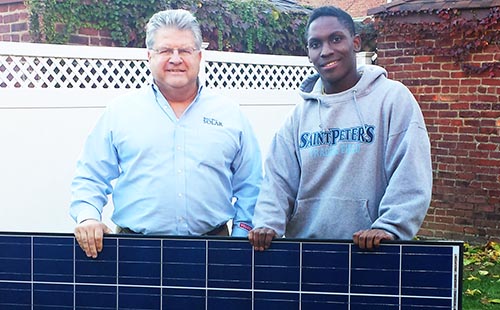
Dan Sabia, President of Built Well Solar (left); Physics and computer science student, Bentley R. D. Whitfield II (right)
By Bentley R. D. Whitfield II
Massapequa, NY — On February 13th, 2014 the Ivanpah Solar Electric Generating System began operation. It is the largest concentrated solar power project in the world. Operating on roughly 3,500 acres of Mojave Desert land in Nevada, Ivanpah will produce enough electricity to power 140,000 homes.
In New York City each block contains roughly 1.26 acres of rooftop acreage. In Manhattan there are approximately 2,000 city blocks, or 2,525 rooftop acres. Manhattan roofs alone have a yield equal to 72.15% of the acreage of the largest concentrated solar power system in the world! All of NYC’s boroughs combined have enough rooftop acreage to possibly triple or quadruple the Ivanpah project. Granted most urban areas don’t have the solar intensity of the desert but they can contribute towards energy independence in a cost effective manner.
How the sun’s energy is converted to electricity is fascinating. The sun is fascinating! Did you know that over a million earths can fit into the sun’s interior? Did you know that NASA estimates the sun will last another 4 to 5 billion years? Our sun is a star and stars are one of the universe’s natural power plants. Made up primarily of hydrogen, continuous nuclear reactions in the sun caused by fusion create energy that eventually reaches the earth.
Most solar panel systems use photovoltaic cells which capture solar irradiance and convert it to electricity. It is then processed through an inverter into useable AC (alternating current) electricity. The Ivanpah system uses solar thermal technology. Large computer controlled mirrors, called heliostats, direct sunlight on to boilers which are located on towers. Water in the boilers is heated which creates steam. The steam powers turbines which generate electricity.
Building major solar projects on urban roofs is a win – win – win for everyone involved. Most solar panel installations now are done by individual homeowners/property owners. There are rebates and tax incentives for individual property owners; however there is still a large initial cash outlay required that is often too much for homeowners to afford. The process would be much more efficient if utility companies or local governments were directly involved by leasing the rooftop acreage from property owners. The companies or governments would install and own the solar equipment and the benefits would be as follows. Property owners would get a new income stream, an improved roof and increased property values. Utility companies will get a clean, renewable source of energy. Jobs will be created for the installation and maintenance of solar panels. Finally, America will take another step towards energy independence by using one of the universe’s greatest sources of power – the sun.
Bentley R. D. Whitfield II is a physics and computer science student at St. Peter’s University. He argues that urban areas are ideally suited for solar power projects and solar power expansion. He makes the case that solar projects conducted as public and private sector ventures will assist the nation in becoming energy independent while creating jobs and improving property values.
PRESS CONTACT:
Bentley R. D. Whitfield II
516 909-1874
bwcwww@yahoo.com
